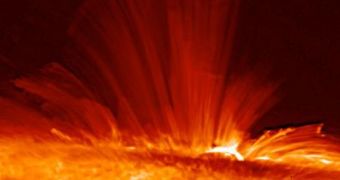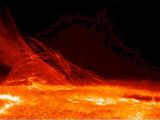The chaotic surface of the Sun has amazed astronomers looking at detailed new images from the Japanese space telescope called Hinode ("sunrise"). "The observatory will have as dramatic an impact on our understanding of the Sun as the Hubble Space Telescope has had on our view of the universe beyond," said NASA researchers.
"Everything we thought we knew about X-ray images of the Sun is now out of date. We've seen many new and unexpected things. For that reason alone, the mission is already a success", says Leon Golub from the Harvard-Smithsonian Center for Astrophysics in Cambridge, Massachusetts, US.
Hinode started its mission in September 2006, being programmed to investigate the solar magnetic field and how magnetic fields expel energy in the Sun's outer atmosphere. The spacecraft, orbiting the Earth in a continuous twilight zone between night and day, employs an optical solar telescope (SOT), an X-ray telescope (XRT) and an ultraviolet spectrometer receiving a permanent view of the Sun.
Hinode has sent back startling images of the Sun's outer limb. These images were expected to see a calm zone named the chromosphere but instead they revealed a boiling mass of mobile spikes. "These structures are 8000 km long and some extend twice that high," said SOT science team member Alan Title from Lockheed Martin Advance Technology Center in Palo Alto, California, US. "Their speed is such that if you sat on the end of one, which I don't recommend, you could travel from Washington, DC, to San Francisco in about four minutes. These things are really moving."
The researchers were also surprised to find out that the giant magnetic field describes a loop that collpses down onto the Sun's surface, something that researchers have never imagined, as they thought it was blowing out into space. "Almost every day, we look at the data and we say - what the heck was that?" said Golub.
Astronomers believe Hinode will enable them to solve many big puzzles.
For a long time now it was observed that the temperature of the Sun's corona (outermost atmosphere) is much hotter than the underneath atmosphere, close to Sun's energy-generating core and the jumbled magnetic fields could explain the energy dump in the corona. "Theorists suggested that twisted, tangled magnetic fields might exist. With the XRT, we can see them clearly for the first time", said Golub.
Hinode could help find the magnetic field configurations that induce the greatest explosive energy releases of all, allowing a better forecast of stormy "space weather", as the solar eruptions can perturb satellite communications and electricity supply networks on the ground.

 14 DAY TRIAL //
14 DAY TRIAL // 
